The Pension Fight Must be Won
• Pensions Are a Right
• Tier Six Cuts Pension Benefits by 40 Percent
• CSEA Testimony on Cuomo Pension Proposal
• The Necessity for Pensions Arose from the Objective Conditions
Pensions Are a Right
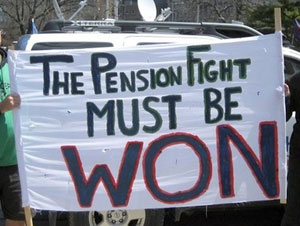 New York Governor Andrew Cuomo has launched a major attack on the pensions of New York public sector workers, demanding they pay more for less (see articles below). Hundreds of teachers demonstrated in downtown Buffalo to oppose the attacks while thousands more workers have protested at the statehouse in Albany. Workers are defending their right to a secure retirement and rejecting the indignity that after years of work their pensions will barely provide a poverty-level existence. Public sector workers provide valuable services to society. Without them schools could not function, pubic transportation could not function, social programs could not be provided. In areas like Buffalo, the third poorest city nationwide, public sector workers also represent the unionized workforce. Their struggles have secured wages, healthcare and benefits above the minimum. Attacking them is a means to lower the standard of living of all workers to poverty level.
New York Governor Andrew Cuomo has launched a major attack on the pensions of New York public sector workers, demanding they pay more for less (see articles below). Hundreds of teachers demonstrated in downtown Buffalo to oppose the attacks while thousands more workers have protested at the statehouse in Albany. Workers are defending their right to a secure retirement and rejecting the indignity that after years of work their pensions will barely provide a poverty-level existence. Public sector workers provide valuable services to society. Without them schools could not function, pubic transportation could not function, social programs could not be provided. In areas like Buffalo, the third poorest city nationwide, public sector workers also represent the unionized workforce. Their struggles have secured wages, healthcare and benefits above the minimum. Attacking them is a means to lower the standard of living of all workers to poverty level.
Pensions are a right. The socialized U.S. economy with its massive wealth produced by the workers can readily provide secure retirement at a U.S. standard to all. The just struggle of the workers for pensions also contributes to strengthening the economy and security of the people as a whole. On the other hand, decimating the pensions and turning over yet more public dollars to the rich, greatly harms the economy.
Instead of acting to guarantee the right to pensions at a U.S. standard, which is the social responsibility of government, Governor Cuomo is engaging in a broad attack on the workers. He claims their pensions represent “runaway costs,” that must be “reined in.” This disinformation, spread by the monopoly media, is an effort to undermine resistance by the workers while justifying yet more attacks.
Pensions are not a cost. They represent deferred wages, wealth produced by the workers that belong to them by right. Public workers contribute to the pension fund and their work is the source of the fund. Labeling them “costs” is an effort to denigrate the workers while making it appear state government is “protecting” the public by “reining in” such "costs." What the government is actually protecting is the right of the monopolies to grab yet more of the public treasury, in this case the massive New York State pension fund. It is one of the largest nationwide and it is fully funded. For the rich, it is a $140 billion pot of gold for the taking. Cuomo makes no secret which side he is on, repeatedly stating he is making sure New York is “open for business.” His job, he says, is to “leverage” state resources for the benefit of business.
New York is a wealthy state. The workers produced its wealth and they have first claim on it, not the monopolies. It is the social responsibility of government to represent society and defend the public, including public workers. Instead government is increasingly endangering the public, as seen in these attacks on pensions and in further undermining education and healthcare. This latest attack on pensions is forcing public workers to double their contributions, work twelve years before they even qualify for a pension and receive much lower benefits on retirement.
The situation demands that workers increase their political organizing and come forward as worker politicians, representing their collectives. Existing politicians at the state and federal level represent the monopolies and defend them. We need politicians that represent our collectives and defend public right against monopoly right. In stepping up the fight to defend pensions, let us also step up our efforts to organize to represent and empower our collectives.
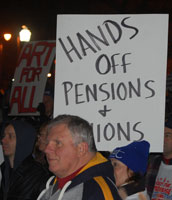


Buffalo, New York teachers and other public workers defend right to pensions and right to education
[TOP]
Tier Six Cuts Pension Benefits by 40 Percent
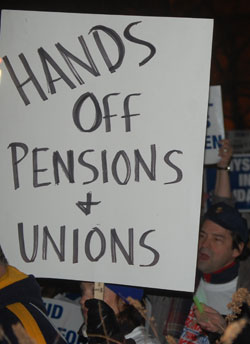 New York Governor Cuomo is currently pushing major cuts to pension benefits of state workers by establishing yet another tier in the statewide pension system, called Tier 6. Overall Tier 6 cuts benefits by 40 percent while doubling contributions by workers, from 3 percent of gross income to 6 percent. It increases the retirement age from 62 to 65 while also requiring 12 years service to qualify for a pension (known as vesting), up from 10. As workers demonstrating against Tier Six bring out, workers pay more and work longer for less.
New York Governor Cuomo is currently pushing major cuts to pension benefits of state workers by establishing yet another tier in the statewide pension system, called Tier 6. Overall Tier 6 cuts benefits by 40 percent while doubling contributions by workers, from 3 percent of gross income to 6 percent. It increases the retirement age from 62 to 65 while also requiring 12 years service to qualify for a pension (known as vesting), up from 10. As workers demonstrating against Tier Six bring out, workers pay more and work longer for less.
Tier 6 also introduces the “option” of a 401k defined contribution pension, well known for providing insecurity in retirement. The defined contribution plans depend on stock market investments and provide no guarantee of benefits at retirement. Existing pensions are defined benefit contribution, meaning the amount received, the benefit, is defined and guaranteed.
Tier 6 also changes how the amount of the pension is calculated, from an average from the last three years of work to the last five. As well, accrued but unused vacation and sick pay cannot be utilized in the calculation. And, what is known as the pension multiplier will be reduced from 2% to 1.67% for each year of credited service, robbing workers of a significant portion of their contributions.
Cuomo’s new attack on pensions comes after major cuts to pensions in 2009, when Tier 5 was established. These cuts to workers are expected to provide $35 billion to the state treasury. The concessions were made in part in exchange for contract language preventing layoffs. However Cuomo quickly took advantage of the “exceptions” language also in the contract to threaten 10,000 layoffs last summer to secure yet more concessions. And now, despite the workers accepting concessions in wages and healthcare benefits, he is demanding major cuts to pensions.
New York State workers have fought hard for pension benefits, so much so that the state constitution includes a clause outlawing cuts to pensions. Article 5, Section 7 of the 1937 state constitution says, “Membership in any pension or retirement system of the state or of a civil division thereof shall be a contractual relationship, the benefits of which shall not be diminished or impaired.”
Instead of guaranteeing this provision by providing pensions on a par with a New York State standard of living, the state gets around this provision by changing the “contract” for new workers. Each tier represents those changes. Tier 3, for example is for workers hired from 7/76-8/83, tier 4 for those from 9/83-12/09 and Tier 5 is for workers hired on or after January 1, 2010.
Before Tier 5, workers contributed 3 percent of their gross earnings towards their pensions for a period of ten years and then nothing after that. The time required to secure a pension (known as vesting) was 5 years. Tier 5 increased the vesting time to ten years and required workers to contribute 3 percent of gross earnings for their entire careers as public workers. Tier 6 will require contributions of 6 percent and 12 years service for vesting — meaning if you work less than that you do not qualify for a pension.
 Cuomo is claiming these attacks are necessary to deal with “runaway pension costs.” The facts are quite different. Average public pension benefits for all state workers are $18,300 yearly. Pensions for county and municipal workers, members of the American Federation of State County and Municipal Employees (AFSCME) union average between $16,000 and $17,000 per year after a career of public service. About 76 percent of all pensions average less than $30,000 a year. These pensions are not even the minimum required to be on a par with the wealth produced and services provided by New York workers. Poverty level for a family of four, which many retirees are contending with given unemployment for their children, is currently $22,113. For one person it is $11,344, meaning a couple trying to live on a pension of $18,300 would be living in poverty.
Cuomo is claiming these attacks are necessary to deal with “runaway pension costs.” The facts are quite different. Average public pension benefits for all state workers are $18,300 yearly. Pensions for county and municipal workers, members of the American Federation of State County and Municipal Employees (AFSCME) union average between $16,000 and $17,000 per year after a career of public service. About 76 percent of all pensions average less than $30,000 a year. These pensions are not even the minimum required to be on a par with the wealth produced and services provided by New York workers. Poverty level for a family of four, which many retirees are contending with given unemployment for their children, is currently $22,113. For one person it is $11,344, meaning a couple trying to live on a pension of $18,300 would be living in poverty.
In addition, NY workers, including teachers, contribute such a large pension fund that 86 percent of pension plan income comes from earnings on pension investments, not public tax dollars. From 1991 to 2003 government employer’s paid less than 2 percent of payroll for pensions. New York’s public pension system is also fully funded. A recent report of state pensions nationwide by the PEW Center said “New York led the way with a funding level of 101 percent—the only state to enjoy a surplus...”
The demand for cuts is not aimed at protecting public tax dollars or providing for the public. On the contrary, it is meant to put yet more of the wealth produced in the service of the monopolies. As Cuomo often says, New York is open for business and its resources will be “leveraged” to serve the monopolies. This includes increasingly putting one of the largest pension funds nationwide at the disposal of the monopolies.
Pensions are deferred wages. They belong to the workers by right. Security in retirement is a right of all human beings and a measure of the humanity of a modern society. Defending the pensions we have and fighting for the pensions we need, today and for future generations is a fight that must be won.
[TOP]
CSEA Testimony on Cuomo Pension Proposal
Francine Turner, Civil Service Employee Association (CSEA) Director of the Legislative and Political Action Department gave testimony to the New York State Senate Finance Committee concerning Governor Cuomo’s 2012-13 Executive Budget Proposal. Below is the portion dealing with Cuomo’s proposed pension reform, which involves adding a Tier 6 to the current pension plan for New York public sector workers (see article above).
* * *
Pension Reform
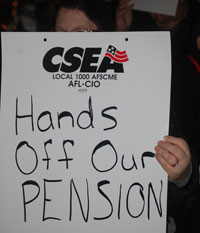 “This fundamental reform of the public sector pension system achieves what the private sector has been doing for years – namely, having employees contribute a fair share towards their pensions.”
“This fundamental reform of the public sector pension system achieves what the private sector has been doing for years – namely, having employees contribute a fair share towards their pensions.”
— Lt. Governor Robert Duffy, Former Mayor of Rochester, speaking in reference to passage of Tier 5 in 2009
Pension reform is not a new concept. With much fanfare from business and government leaders, New York State enacted a new pension tier just two years ago. In fact, former Rochester mayor Robert Duffy, now the Lieutenant Governor, cheered this change by saying that public employees are now paying their fair share. At the time, the Governor and legislative leaders said that this new pension tier would save $35 billion over 30 years. Unfortunately, however, it seems as if many have already forgotten about the changes made. This new tier included an increased minimum retirement age for all new public employees, doubled the years of service required to vest (qualify for a pension), required employees to contribute to their pensions for their entire career (instead of ten years) and capped the amount of overtime that can be considered in the calculation of pension benefits. These changes were not easy to get done but they happened and as more employees enter public service, the savings will only increase.
Despite these reforms, Governor Cuomo proposes to slash pension benefits for future retirees through the creation of a Tier 6. The new tier would apply to employees hired after April 1, 2012. It would raise the minimum retirement age from 62 to 65, increase employee contributions based on a person’s salary, increase vesting time from 10 to 12 years, exclude all overtime from a person’s final average salary, and base a pension on the final average salary for five years, rather than the current three. There is also a provision for sharing the risk and the reward based on the employer contribution.
If the employer contribution rate exceeds 7 percent in any given year, the amount by which it exceeds 7 percent would be paid for equally by the employer and the employee. For example, if the employer contribution rate went to 9 percent in 2013, the employer would pay an additional 1 percent and the employee would pay an additional 1 percent. If the employer rate goes below 4% percent the employee contribution would be reduced by one half of the difference of 4 percent and the new employer rate.
Governor Cuomo would lead you to believe that it is an option to enroll into a 401(k) retirement plan rather than a defined benefit pension. In reality, the Executive proposal would force new public employees into the defined contribution plan by offering an alternative that is woefully inadequate to other pension plans offered by New York State. In addition to the reduced benefits, the 401(k) retirement plan offers what seems to be an attractive option for lower paid public employees. This option does not require employees to contribute anything to their 401(k), which can be appealing when every dollar counts. Many employees, especially those just starting in public service, are riddled with student loans, car payments, housing expenses and are at the bottom of the pay scale. Factor in that newly hired employees do not receive a full paycheck for the first twelve weeks in state service creates an incentive for public employees to be misled in the 401(k) retirement option.
CSEA has no hesitation in saying that the proposal for a new public employee pension tier is an assault on the middle class. It will provide no short-term savings to the State or localities and would only mean that working people would have to work longer, pay more and benefit less. Simply put, the Tier 6 provisions would be onerous on working people and undermine retirement security for thousands of New Yorkers.
Governor Cuomo insists that pensions are not a lifetime legacy. He claims that Tier 6 does not impact any current employees and this proposal would affect future workers that are not hired yet, what he terms the “unborn.” CSEA disagrees with Governor Cuomo.
We believe that a solid source of retirement security after a career in public employment should be something that New York should pride itself in. When Governor Cuomo talks about the “unborn,” he is talking about our children and grandchildren. Governor Cuomo may be satisfied with allowing Wall Street to gamble with their retirement but we are not.
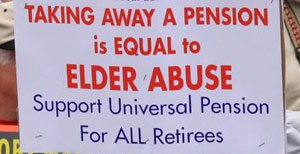 A secure retirement is slipping away from American workers. More than half are at risk of not being able to maintain their standard of living in retirement and the average 401(k) account is worth only $75,000. Not coincidentally, this retirement insecurity comes at a time when the number of people with defined benefit pensions is declining.
A secure retirement is slipping away from American workers. More than half are at risk of not being able to maintain their standard of living in retirement and the average 401(k) account is worth only $75,000. Not coincidentally, this retirement insecurity comes at a time when the number of people with defined benefit pensions is declining.
We are facing a ticking time bomb in this country. Contrary to what many say, it is not public employee pension funds. It is the fact that when baby boomers retire, with minimal 401(k) savings and fewer and fewer with a defined benefit pension, retirees are going to run out of money. A $75,000 401(k) balance can only last so long before the money is just gone. When this happens, where will retirees eat, live, and get the basic necessities just to live everyday? The National Institute on Retirement Security showed that spending on public assistance for the elderly would be about 40 percent higher without defined benefit pensions. In other words, taxpayers are going to end up paying for Governor Cuomo’s proposal in the long run.
Governor Cuomo’s budget presentation attempted to persuade you to believe that the state needs to switch to a defined contribution retirement plan to mirror the changes we have seen in the private sector. This is a false choice. As Comptroller Thomas DiNapoli recently said, 401(k)s were never intended to take the place of pensions. They were meant to supplement pensions and Social Security, not be used as the primary means of income for retirement. Defined benefit pensions work and New York is proof of that. Public pensions in New York result in an estimated $6.5 billion in spending, $9.5 billion in economic activity, and $1.3 billion in property taxes paid annually. They allow individuals to know that they will have a basic level of retirement security, regardless of whether the stock market reaches new peaks, or sinks to the lowest valleys. A 401(k) does not guarantee that. As we have seen during the Great Recession, 401(k)s only benefit people who happen to be able to retire at the right time. People who could not retiree pre-2008 have seen their investment accounts plummet, thus pushing retirement off for years, if not forever.
The 90 years that the state has been providing pension benefits demonstrate that the system works. Pensions are long-term vehicles that should not be overhauled with every change in the political wind. Supporters of a new pension tier argue that the pension system is unsustainable. What is unsustainable is a society where each generation of workers retires with less financial security than the one before. We urge you to stand up for retirement security for all New Yorkers and reject this proposal.
[TOP]
The Necessity for Pensions Arose from the Objective Conditions
 Pensions are a modern feature of life. They arose as a necessity because of changes in the economic base and the relations among people during the last four hundred years.
Pensions are a modern feature of life. They arose as a necessity because of changes in the economic base and the relations among people during the last four hundred years.
The transformation of the economy from petty production to industrial mass production precipitated changes in the objective and subjective conditions beyond the control of any individual. Industrial mass production gradually transformed a mostly rural setting of extended families engaged in subsistence agriculture and other petty production and created a modern urban life of small interconnected families within an extended society consisting of a socialized economy, public education, science, information, public health, mass culture and forms of general welfare.
The many small families of today, some consisting of but mother and child or even single individuals, are joined together in society. Society has become the modern extended family and people are born to that extended family — society.
The previous subjective outlook reflected the objective conditions of a mostly rural life within a self-sustaining extended family that cared for its members as best it could. The watchword was one for all and all for one within the extended family. The bond of the extended family was nurtured in culture, religion, tradition and fixed in class privilege and rank. Family property, especially productive property such as farmland whether owned or held as a communal or feudal right, and the right of membership in guilds, manors, clans and villages was fiercely guarded and passed on to young family members as the material guarantor of their individual and collective welfare. The old outlook was founded on class privilege and rank, and the belief that the world and social relations were static and ordained by a supreme being and any change contradicted the natural order.
Changed Objective Conditions
The new objective conditions of today demand a modern outlook of members of society that rejects the old one based on class privilege and rank. The objective basis and practices of extended families no longer exist except in the wealthiest families that own social property but soon they too fall apart as inheritance and infighting divides social property, and bankruptcy consolidates ownership of social property in fewer hands.
Most Americans must sell their capacity to work to gain a living. Inheriting the capacity to work is very different from inheriting a small farm or rank in a protected guild. Successive generations of workers inherit the capacity to work and a claim on the value they produce but not ownership and control of the socialized means of production. Workers depend on a claim on the wealth they produce or service they provide, which in turn is only guaranteed by their capacity to work and whether they can sell that capacity or not. The modern world is fraught with insecurity and crises because the actual producers do not own or control their means of production. When not working for whatever reason, workers must depend as best they can on the wealth generated by other workers and distributed through social programs, but at this time, that dependency lies beyond their control because they do not control the socialized means of production and the general economic and political affairs of the country.
The wealth workers create through work to transform the bounty of Mother Nature into use-value is claimed partly by workers who are the actual producers, partly by governments and partly by the small number of owners of parts of the socialized productive forces.
The means of production and means of providing services cannot be inherited by the offspring of the actual producers for modern workers only possess their capacity to work, which they sell to earn a living. When workers lose their capacity to work through accident, illness or old-age or when owners of capital refuse to buy their capacity to work for whatever reason and workers' capacity to work languishes unsold on the labor market, they must rely on society to guarantee their welfare, for society is the new extended family of the modern world.
Subjective Outlook Lags Behind the Objective Changes
The changes in the objective conditions from petty production to industrial mass production necessitate a change in the subjective outlook guiding society. The changed conditions should move humanity towards a broader outlook of personal and social welfare resting in the bosom of society. One for all and all for one no longer resides in the extended family but in the broader family of society. Concern for the well-being of all humanity and society itself is paramount for the well-being of each individual. Harmonizing the relations among individuals and between individuals and their collectives and society itself should guide activity.
The well-being of one and all is found in nurturing and developing the human factor/social consciousness and treasuring the collective public property, the socialized means of production and means of providing services. An outlook that reflects the changed conditions would assert the social and political responsibility to defend the security and rights of every individual and the general interests of society into which all are born. This demands as well that the socialized means of production and means of providing services are passed to the next generation of workers in better condition than when they were handed over to the current generation. The rejection of class privilege and the demand for control and inheritance of social property by the actual producers are paramount to a new outlook in conformity with the changed conditions. Guided by a modern outlook, Americans can build a society of socialized humanity fit for human beings in which the rights of all are recognized and guaranteed. The right to a U.S.-standard pension equivalent to a standard while working is one of those modern rights.
[TOP]
